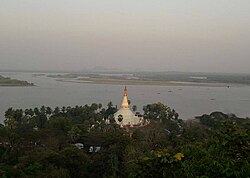Mottama (Burmese: မုတ္တမမြို့, pronounced [moʊʔtəma̰ mjo̰]; Muttama Mon: မုဟ်တၟံ, [mùh mɔˀ]; formerly Martaban) is a town in the Thaton District of Mon State, Myanmar. Located on the west bank of the Thanlwin river (Salween), on the opposite side of Mawlamyaing, Mottama was the capital of the Martaban Kingdom (later known as Hanthawaddy Kingdom) from 1287 to 1364, and an entrepôt of international repute until the mid-16th century.
Mottama
| |
|---|---|
Town | |
 | |
| Coordinates: 16°31′48″N 97°36′08″E / 16.53000°N 97.60222°E | |
| Country | |
| State | |
| District | Thaton District |
| Population | |
| • Ethnicities | Mon Burman Karen |
| • Religions | Theravada Buddhism |
| Time zone | UTC+6:30 (MST) |
Etymology
edit"Mottama" derives from the Mon language term "Mumaw" (Mon: မုဟ်တၟံ; /mùh mɔˀ/), which means "rocky spur."[1][2]
History
editPrior to 15th century
editFrom the 2nd century BCE to the 15th century CE, Martaban was an important trading port. The historic Maritime Silk Road connected the East and West, and Martaban storage jars were imported through this trade route.
The earliest evidence of the existence of Martaban in Myanmar history was revealed in an inscription erected by King Sithu II of the Bagan Empire in 1176.[3]
The ancient city was called Sampanago (Campа̄nа̄ga, lit. City of Serpents) or Puñjaluin in the Mon language. It may also be referred to within the context of Muttama-Dhañyawaddy or Sampanago-Lakunbyin as a roughly 45 kilometer stretch or settlements along the Salween River stretching from modern day Mottama to Hpa-an. Artifacts from the Sampanago site support a thriving sixth to ninth century culture with trade to other early sites over land and across the sea. Coins and cultural influences in artifacts indicate that Sampanago had close contacts with Thaton and early sites in U Thong and Kanchanaburi[4]
In the 13th century, Martaban was a southern provincial capital in the Bagan Empire. After Bagan's collapse in 1287, King Wareru founded the Martaban Kingdom based out of Martaban.[5]: 205–206 The city was the capital of a Mon-speaking kingdom from 1287 to 1364. Nominally it was a vassal state of the Thai Sukhothai Kingdom until 1314.[6] From 1369 onwards, the Hanthawaddy kings ruled the kingdom from Bago (Pegu).[7] From 1364 to 1388, Martaban was under the de facto independent rule of Byattaba. In 1388, King Razadarit reconquered the city.[8] Though it was no longer the capital, the city remained an important trading port from the 14th century to the early 16th century.[9]
The old name of the city, Martaban, came to mean 'jar' in several varieties of Arabic, and internationally for the large ceramic jars that were characteristic of the city's exports. In Egyptian Arabic, by metathesis, the word has changed to become batraman, and refers to any glass or ceramic jar.
16th to 19th centuries
editIn 1541, King Tabinshwehti of Taungoo captured the fortified city, and utterly destroyed it, forever relegating it back to a backwater. From the 16th to the 19th centuries, Martaban was a strategic spot in a series of wars fought between Burma and Siam.
Colonial Period
editMartaban was captured by the British in the First Anglo-Burmese War of 1824–1826, but returned to Burmese administration after the war. It became the border town however as the entire Tenasserim coast from Mawlamyaing down became British territory. The town became part of British Lower Burma after the Second Anglo-Burmese War of 1852.
Rudyard Kipling refers to Martaban in his poem "In the Neolithic Age": "And the crimes of Clapham chaste in Martaban," suggesting he perceived it to be a place where immoral behavior was tolerated.
Geography
editThe Salween River flows through the town into the Bay of Martaban. The town's location is adjacent to the confluence of five rivers – the Salween, the Ataran, the Gyaing, the Dontami, and the Hlaingbwe – as they empty into the Gulf of Martaban. The town is also surrounded by hills that continue located in the Salween valley where various crops are cultivated.[4]
Transport
editMottama was the terminus of the road and the railroad from Yangon, where the Thanlwin empties into the Gulf of Martaban in the Andaman Sea. Today Mawlamyaing Bridge has laid down a link from Mottama to Mawlamyaing and another city in the south Ye.
Notes
edit- ^ Shorto, H.L. (1962). Dictionary of Modern Spoken Mon. Oxford University Press. Archived from the original on 24 January 2021. Retrieved 10 October 2018.
- ^ Tun, Than (1988). "Observations on the Translation and Annotation of the Royal Orders of Burma". Crossroads: An Interdisciplinary Journal of Southeast Asian Studies. 4 (1): 91–99. JSTOR 40860260.
- ^ Aung-Thwin, Michael (2005). The mists of Rāmañña: The Legend that was Lower Burma (illustrated ed.). Honolulu: University of Hawai'i Press. ISBN 9780824828868.
- ^ a b Moore, Elizabeth; San Win (2014). "Sampanago: "City of Serpents" and Muttama (Martaban)". In Revire, Nicholas; Murphy, Stephen (eds.). Before Siam was Born: New Insights on the Art and Archaeology of Pre-Modern Thailand and its Neighbouring Regions. River Books. pp. 216–237.
- ^ Coedès, George (1968). Walter F. Vella (ed.). The Indianized States of south-east Asia. trans.Susan Brown Cowing. University of Hawaii Press. ISBN 978-0-8248-0368-1.
- ^ Mukherjee, Rila (2011), Pelagic Passageways: The Northern Bay of Bengal Before Colonialism, Primus Books, p. 212
- ^ Harvey 1925: 368
- ^ Fernquest 2006: 7–8
- ^ Myint-U 2006: 67
References
edit- Jon Ferquest (Spring 2006). "Rajadhirat's Mask of Command: Military Leadership in Burma (c. 1384–1421)". SBBR. 4 (1): 7–8.
- Harvey, G. E. (1925). History of Burma: From the Earliest Times to 10 March 1824. London: Frank Cass & Co. Ltd.
- Myint-U, Thant (2006). The River of Lost Footsteps—Histories of Burma. Farrar, Straus and Giroux. ISBN 978-0-374-16342-6.
